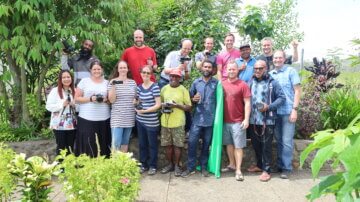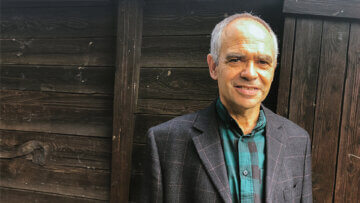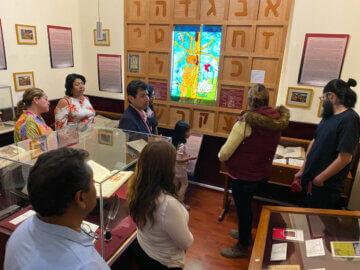Introduction: The Wycliffe Global Alliance and Bible Translation Movements
Synopsis
The nature of global missions is changing. For the first time in modern history, the number of Christians in the global South and East has exceeded those in the West. The goal of this research is to identify implications for the Wycliffe Global Alliance in respect to the church’s demographic shift from the West to the global South and East.
Using a missiological and theological framework, the Wycliffe Global Alliance seeks to change its strategy and structure in order to transform itself from an international mission agency to a global alliance that both participates, and takes greater leadership, in movements for Bible translation.
The research reflected in the following articles covers only the Wycliffe Global Alliance (formerly called ‘Wycliffe Bible Translators International’) and not SIL International, a strategic partner of the Alliance, though the two organizations share much common history.
The structure and content of these articles is as follows:
The second through fourth articles provide an overview of mission history, in particular the history of Wycliffe in the context of the development of Bible translation as part of the missio Dei.
Articles five through seven investigate theological implications such as contextualization issues that come from providing the Bible in the vernacular, which is basically a theologizing activity.
Articles eight through thirteen explore the missiological foundations, including that of mission history in Bible translation, and the resulting mission practices that have shaped many mission agencies, especially the Alliance.
Articles fourteen through sixteen explore leadership themes that help or hinder the changing nature of international mission, mission structures and mission societies. This section concludes by exploring the Wycliffe Global Alliance’s leadership development process.
Article seventeen outlines the conclusions that follow from the previous sections.
The series concludes with article eighteen, which lists the references used throughout.
Full Article: Article 1 - Introduction: The Wycliffe Global Alliance and Bible Translation Movements
Purpose
The goal of my research, now presented in this series of articles, was to identify the implications for the Wycliffe Global Alliance in respect to the Church’s demographic shift from the West to the global South and East. My underlying assumption was that the organization must transform itself from an international mission agency to a global alliance that participates in, and takes greater leadership in, movements for Bible translation.
Underpinning this research is a missiological and theological framework that helps determine how the Wycliffe Global Alliance might realize its overall vision and in particular its Vision 2025. With Christianity’s centre of gravity moving away from its Western roots, this study recommends changes to the strategy and structure of the Alliance.
With Christianity’s centre of gravity moving away from its Western roots, this study recommends changes to the strategy and structure of the Alliance.
An understanding of Vision 2025 provides important background for this research. The vision has many components. One quantifiable goal is, through partnership and under God’s guidance, to have a Bible translation program in progress for every language that needs it by the year 2025. When the vision was adopted in 1999 the number of languages needing Bible translation was about 3,000 (plus or minus 10 percent). Now, it is about 2,000. Apparently new strategies inspired by the Vision are already making a difference. But is this sufficient?
For the Alliance to realize fulfilment of Vision 2025, it must reconsider its interaction with the objectives of the Church of the global South and East. These expressions of the Church, in all of their theological and geographical diversity, will probably have different priorities concerning Bible translation than their Western counterparts. This is also a challenge because, in the past, the Wycliffe Global Alliance did not always consult with or respond to the Church’s missional interests.
Clarifying terminology
It is problematic to make geographical statements about the growth or location of the Church worldwide. For example, when referring to the ‘Western Church’ or the ‘West’ in general, it is more appropriate in Latin America to refer to the West as the ‘North’ since the United States and Canada are located in the North, not the West. Another problematic term is the ‘global South’ or the ‘Church of the southern continents’ (e.g. Africa, Asia, the Pacific Islands, the Caribbean and Latin America). A more accurate description is to add ‘East’ since the Church in Korea and China is in the East, not the South. Therefore, for the sake of continuity in this research, when the terms ‘West’ or ‘Western’ are used, they include those who prefer ‘North’ or ‘Northern’ terminology. Likewise, ‘global South and East’ is used instead of other variants.
It is important to note that this research was focussed solely on the Wycliffe Global Alliance. From 1980-2011, this organization was called ‘Wycliffe Bible Translators International’ (WBTI). It did not become an alliance until 2011. However, the name Wycliffe Global Alliance, or simply “the Alliance” will be used throughout. In certain contexts the generic ‘Wycliffe’, ‘Wycliffe Bible Translators’ or ‘WBT’ may be used. When this is done it most likely refers to organizations and organizational structures or historical contexts that pre-date 1991 when WBTI was restructured.
The focus of this research is only on the Wycliffe Global Alliance and not SIL International, a strategic partner of the Alliance, although the two organizations share much common history. Until the 1990s, the two organizations shared the same structure and resources. Often they were thought to be entirely the same by friend and foe and many people used the two names ‘Wycliffe’ and ‘SIL’ interchangeably. They are, however, two distinct organizations.
The Church’s Demographic Shift
There are numerous studies about the changing demographics of the global Church. From them we learn how, for the first time in modern history, the number of Christians in the global South and East has exceeded those in the West. Philip Jenkins describes this shift as “one of the transforming moments in the history of religion worldwide” (2002:1). Mark Noll writes, “it is as if the globe [has] been turned upside down and sideways. A few short years ago, Christian believers were concentrated in the global North and West, but now a swelling majority lives in the global South and East” (2009:19). Jenkins further states that the “center of gravity in the Christian world has shifted inexorably Southward to Africa, Asia, and Latin America” (2002:2).
In the annual table of the status of Christian mission, Todd Johnson, David Barrett and Peter Crossing (2011:29) give a comparison of the growth of the church between 1900 and 2010:
Lamin Sanneh calls this notable shift to the global South and East, “Christianity’s new stronghold” (2008:275).
Samuel Escobar states: “In the twenty-first century, Christian mission has become truly international, and in order to understand this phenomenon we need a paradigm change in our way of studying it that corresponds to the change in the way mission is now taking place” (2003:19). This gives credence to a re-examination of mission theory and practice.
The research that follows heeds Escobar’s call for a re-examination, in anticipation that it will lead to insights about how and why the nature of global mission is changing and in particular how this impacts the Wycliffe Global Alliance.
“In the twenty-first century, Christian mission has become truly international....” -Samuel Escobar
The research explores intersecting themes pertinent to mission in the 21st century such as issues of contextualization, the impact of Bible translation in mission history, leadership and mission agency leadership development, missiological influences on mission strategy, globalization in mission and other factors. My research goal was to determine how these influence the strategy and structure of the Alliance and in turn how the Alliance should respond.
As a conclusion to my research, I provide insights into specific ways the leadership of the Alliance needs to implement changes necessary to realize its vision.
In summary, the goals of the research were: 1) an overview of the understanding of the changing context of the Church because of its demographic shift to the global South and East; 2) an analysis of how this influences the current and future direction of the Wycliffe Global Alliance; resulting in: 3) practical applications to the strategy, structure and leadership model of the Alliance.
Outline
The structure of the thesis (reflected in subsequent articles in this series) is as follows: The second through fourth articles provide an overview of mission history, in particular the history of Wycliffe in the context of the development of Bible translation as part of the missio Dei. The organization’s past 80 years are summarized and the lessons learned from this period are outlined.
Some might ask why a historical approach is important to the research. Andrew Walls states that the New Zealand Maoris “speak of the future as being behind us. We cannot see it. The past is what is in front of us. We can see that stretched out before us, the most recent plainly, the more distant shading away to the horizon” (2002:1). This insight about history means one cannot say what will happen to the Church of the future. However, what we can do is follow Walls’ advice and “look at the past in front of us and see what it suggests of the way that we have come and perhaps read in outline, as on a sketch map, the place to which we have been brought now” (2002:1).
Articles five through seven investigate theological implications such as contextualization issues that come from providing the Bible in the vernacular, which is basically a theologizing activity. This topic is important because, as Kwame Bediako states, “Christianity has become a non-Western religion; which means, not that Western Christianity has become irrelevant, but rather that Christianity may now be seen for what it truly is, a universal religion, and that what has taken place in Africa has been a significant part of this process” (2004:3). African Christianity, as observed by Bediako, is a vernacular religion because the 19th century missionary movement into Africa gave priority to Bible translation in African languages. Equipped with the vernacular scriptures and largely released from the influence of the West, theology was and continues to be contextualized into African forms.
The way the Bible is read and understood by Christians in the South and East impacts the importance of Bible translation in these regions.
A related topic explored in article seven concerns how the Church of the global South and East have taken the vernacular Bible seriously. This was critical to the research because, as Jenkins observes, the Bible is read differently in the South and East than it is in the West. In particular, he notes that Christians from the South and East have,
a much greater respect for the authority of scripture, especially in matters of morality. They also have a willingness to accept the Bible as an inspired text and have a tendency to literalism, with a special interest in supernatural elements of scripture, such as miracles, visions, and healings, a belief in the continuing power of prophecy, and a veneration for the Old Testament, which is considered as authoritative as the New. (2006b:4)
It follows clearly that the way the Bible is read and understood by Christians in the South and East impacts the importance of Bible translation in these regions. This affects the Alliance because of its roots in the West, a region now known for a general disregard of the relevance of the Bible.
Articles eight through thirteen explore the missiological foundations, including that of mission history in Bible translation, and the resulting mission practices that have shaped many mission agencies, especially the Alliance. I suggest how these foundations should influence the future of the Alliance in the global mission context. Mission agencies do not operate in a vacuum but usually are affected by the churches that support and sustain them. James Engel and William Dryness (2000:18) outline three trends that Western mission agencies should consider: 1) how they are captive to their home cultures including Western political and economic pragmatism; 2) the initiatives for mission as they shift to younger churches; and 3) the loss of the theological roots of mission. These and other reasons give compelling support to investigating this theme.
Articles fourteen through sixteen explore leadership themes that help or hinder the changing nature of international mission, mission structures and mission societies. This section concludes by exploring the Wycliffe Global Alliance’s leadership development process. This is important to the research because of the kind of mission leadership required in rapidly changing global contexts and in particular because this will affect mission agencies, like the Alliance, that originated in the West.
Article seventeen outlines the conclusions that follow from the entire series. These conclusions are intended to guide Alliance leadership in achieving and implementing the recommendations from the research. Some unresolved areas in the research that need further investigation are also mentioned.
The series concludes with article eighteen, which lists the references used throughout.
The latest
View all articles
03/2024 Pacific: Papua New Guinea
Informing, teaching, inspiring: PNG workshop teaches video storytelling for language communities
PNG workshop teaches video storytelling for language communities
Read more
02/2024 Global
Looking ahead at 2024
As the year unfolds, we marvel at the work of God in our rapidly changing world. And, we look forward to a number of gatherings and conversations intended to draw us together.
Read more
01/2024 Americas
Telling the Bible's Story
It may come as a surprise that a museum is among the Wycliffe Global Alliance organisations.
Read more
